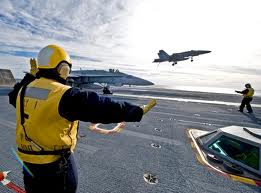Here on the Afterburner Club, we beat the drum a lot on fighter pilot training, fighter pilot training, and fighter pilot training some more.
A recent fire on deck of the U.S.S. Carl Vinson in the Arabian Gulf proves once more how valuable fighter pilot training is in any duty condition, be it during peacetime or war.
 An F/A-18C performing touch-and-go takeoffs and landings on deck had just lifted off when one of the engines had caught fire.
An F/A-18C performing touch-and-go takeoffs and landings on deck had just lifted off when one of the engines had caught fire.
The fighter pilot had noticed this immediately, but instead of panicking and ejecting right away, he implemented the emergency procedures that had been drummed into his brain ever since he started training at NAS Pensacola.
He went around and landed his fighter pilot jet as soon as possible.
The guys on deck weren’t just sitting around idling during the exercises either. They had pounced on the situation immediately on detection of the fire and had positioned themselves to get on the fire as soon as the F/A-18 landed.
There were on top of it and covering the flaming engine with foam within 10 seconds of the aircraft touching down.
The Chief Petty Officer in charge of the firefighting team had good reason to express his pride in the men under his command whose fast action had saved an aircraft.
They had drilled day-in and day-out for just this kind of emergency. And the pilot’s own training in emergency procedures contributed to the saving of his aircraft as well as his own life.
On your road to becoming a fighter pilot, training for these kinds of contingencies shouldn’t wait for when you make it into flight school. You can start training for emergency procedures even now.
Even if you can’t afford flying lessons at the moment, you can go to your local flight school and pick up a checklist that the school may have on emergency procedures and begin memorizing them. Pretend that the mission planner in tomorrow’s flight briefing will quiz you on them.
This is done a lot in flight briefs, particularly on out-of-control procedures. If you are quizzed on those in a Marine Corps flight brief and cannot recite them straight from memory, you probably won’t go flying that day.
Training saves lives! So get on it! By the time you get into flight school, you will be LIGHT-YEARS ahead of the curve.
Can you tell us about an instance where knowing an emergency procedure has helped you stay safe or even save someone else’s life?
And… which emergency procedures do you think are the most important?
Guillaume Hajek says
I haven`t encountered a situation where knowing my emergency procedures helped me save my own life but I did encounter one where not knowing them could have been a real problem. Here my problem was that I was not able to identify what the problem was quick enough given my altitude. I remember I was with my instructor in a cessna 150 and we were doing a nav flight. When it was time to fly back home we were aligned on the runway of a very small airport that had no control tower. Another plane was about to go on the runway in front of us to take off as I was taking some time to complete all my engine checks. When he realized that the other plane was going to go on the runway he urged me to complete my checks quicker in order to take off, which I did. When I took off I noticed that the plane was taking significantly longer to reach its usual take off speed. Once in the air I saw the airspeed drop dangerously low while I was only at about 150 feet high. So I slammed the stick forward to avoid stalling but I couldn`t figure out what the hell was wrong. Then my instructor told me to retract my flaps: when I was rushing during my checks before take off I had accidentally put my flaps at 20 degrees. I`m not sure what would have happened had I been alone but I did get a few lessons out of that experience. Never rush when you are in a plane, know your procedures and don`t give in to an instructor who is telling you something you know can lead to mistakes.